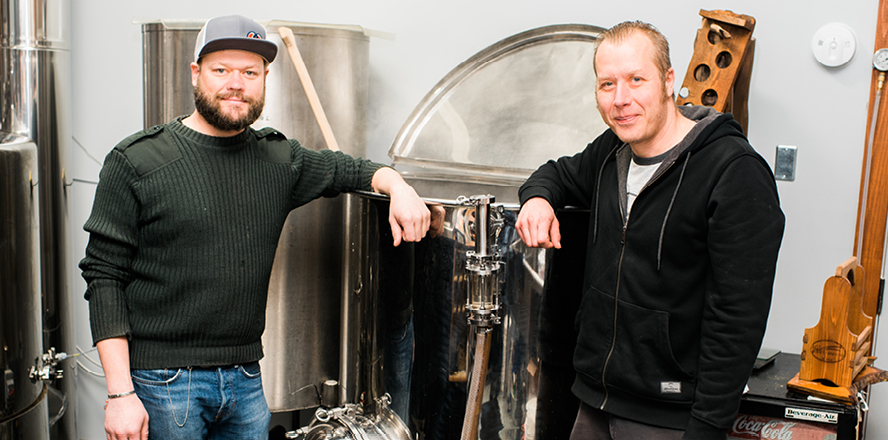by Deborah Rogers –
It won’t have escaped the notice of anyone who’s been in a liquor store recently that there’s been an explosion in the beer section. Craft brewing is having a day (well, a decade) and there are more varieties than you could reasonably sample. What’s interesting is that they’re coming from small breweries all around Vancouver Island and B.C. The choice is sometimes overwhelming, and with wild and wacky names (a glass of Creepy Uncle Dunckel anyone?) you don’t always know what it is you’re going to be getting. I’ve started to wonder: how are all these interesting flavours produced; just what is it that’s going on behind the scenes at the brewery?
Cousins Daniel and Ben van Netten kindly agreed to show me what’s what at their brewery on Mills Road in North Saanich. Howl Brewing was only established in 2018, but it’s been an idea in the works for many years while Dan worked behind the bar at Spinnakers and the two of them made trips back and forth to Europe learning the history, secrets and skills of making small batch beer in a traditional style.
As we start our interview, a large stainless steel kettle is being filled with hot water. Howl Brewing is classified as a Pico Brewery (smaller than micro, smaller even than nano), meaning they will produce just a fraction of the output of a traditional commercial brewery. The batch that’s being started in front of me will make 270 litres of real ale. Whatever the volume produced, beer has the same simple base ingredients: water, grain, yeast and hops (or another flavour provider). Into the kettle large sacks of barley are tipped – the degree of roasting determines some of those caramel or coffee flavours. Then there’s a pause while the grain sits.
Did you know that there is a yeast library? I didn’t either! If you want to make interesting, characterful brews, you need exciting and varied strains of yeast grown for the purpose. And here’s where the brewers become really animated as they discuss attenuation and flocculation: basically the conversion of sugar to alcohol and the way the yeast behaves. It’s clear to me that beer brewing is the perfect venture for these self-professed makers, bakers, builders and gardeners. Yes, you can follow a recipe and produce a consistent product, but it’s the experimentation that appeals to enthusiasts like Dan and Ben.
Their interest is really connected to the farm-to-table ethos, making the brewery’s home at The Fickle Fig Farm Market all the more appropriate. The Mills Road venue is perfect as they find themselves visited by farmers and growers who are keen to share their harvest surpluses. This leads to spontaneous, seasonal brews of (for instance) a plum beer, or a blackberry lavender saison. And people who happen to have hops plants, yet no desire to home-brew, will bring them by.
Back to the brew at hand, and after sitting the grain needs sparging. This is a process of flushing the sugars out of the grain mash by spraying with fresh water. Then there’s some jiggery pokery with a pump and hoses to move the liquid into another large kettle. The leftover mash goes to a local farmer for cattle feed. It’s an interesting mix of agriculture, industry and kitchen. It’s small scale but still a professional, tightly regulated process. There are peeks into the vats, judicious checking of temperatures, colours etc. but the brewer gets to play too when they select the flavour profiles to add.
Both Dan and Ben are interested in traditional brewing and the use of herbs and other plants. They’ve experimented with juniper branches as well as the produce people bring by. For this year’s Victoria Beer Week they have produced an ancient “Druid” beer made with herbs, yarrow, rosehips, dandelion and mushrooms. There’s so much backstory to each of the beers they brew, I can’t recommend enough stopping by to sample when you have the time to learn a bit about what you’re drinking.
As for this batch of IPA, now that the beer wort is in the kettle, it’s heated to boiling and then the flavour gets added. After boiling it gets cooled using a heat exchanger, then the liquid is transferred again into the fermenter. Yeast is added and it’s left to do its work for five to seven days. At this point the beer is carbonated.
At Howl their beer is not pasteurized or filtered: it’s a real ale experience, and one that’s pretty similar to how it’s been made throughout the centuries.
What do you want Deb to peek behind the scenes of next?
Email news@seasidemagazine.ca with your ideas or an invitation!




